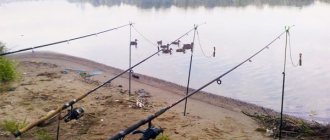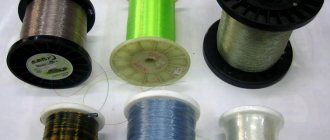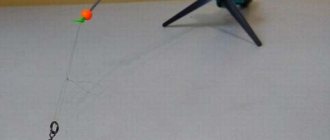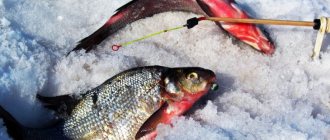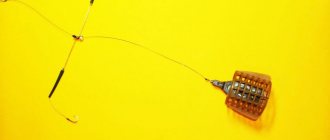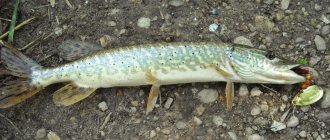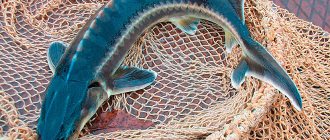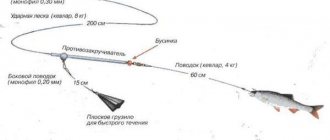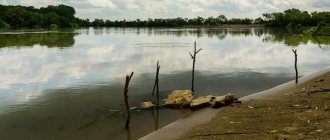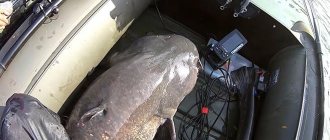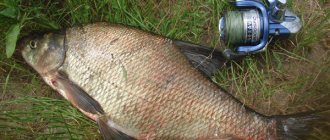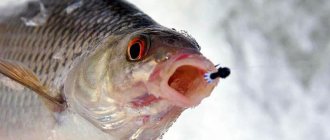In the mornings the Volga resembles a large lake. There is almost no current, and stripes of greenery stretch along the banks. The shutters of hydroelectric power stations usually open around ten o'clock. Only then can you start the engine and go to your proven places. Such places are mostly located on the high right bank of the Volga near the village of Kokshaysk, where the depth is greater and the current is stronger. There you need heavy gear and powerful anchors. Donka “ring” with a kilogram of lead in the feeder is the most popular tackle. Large ides and bream stay here and from time to time make themselves known with sharp bites and the ringing of a bell at the guardhouse of the side bottom. But all this is possible when the current is given. Early in the morning, if you can’t sleep, all you can do is admire the beauty of nature.
Today time is moving slower than ever
Sergei and I leave the backwater by motor and move towards the island, which stretches in a long spit along the Volga. This is where sabrefish are usually caught in the summer. On the island I check the still calm coastal waters with a spinning rod. Maybe the asp will take it? No, silence and stagnation, both on the water and in the bite. My friend only caught a perch using a tandem of spinners.
In order not to wastelessly stare at the water, I take out the feeder, fill a 40-gram feeder with Fishbait Gold Bream Vanilla bait and send the hooks with worms and maggots about thirty meters from the shore, where at least some movement of the water is noticeable. Sergei went to the other side of the narrow island with a spinning rod.
Choosing bait and equipment for catching large pike
Jig tackle is used for catching pike at any time of the year, throughout the entire period of open water, but jig fishing is most effective in early spring and autumn, when the large predator moves to the depths. The classic soft bait for jig fishing for pike on the Lower Volga is a large twister with a wide tail. The color can be varied, it doesn’t matter much, especially when fishing from depth and in muddy water. If the depth is shallow, the water is quite clear, most often local pike prefer twisters of white, light green and yellow colors, as well as contrasting combinations, for example, red head (white with a red head), black and yellow, blue and white. As a variant of jig bait, foam fish are also used, which pike and pike perch readily peck from the bottom in spring and autumn. From experience, the color of the body of the foam rubber does not matter at all. Soft baits attract pike primarily by their unique vibrations, reminiscent of a weakened fish that moves with difficulty. The weights of the jig heads, be it a classic hook soldered into a lead weight or a Cheburashka, hinged with an offset hook, or even a bullet on a steel leash such as a Carolina rig, must be heavy enough to “pierce” a sufficient thickness of water in case of fishing on the riverbed under strong conditions. flow. In Trekhrechye, when fishing on riverbeds, the weight of jig heads is selected depending on the situation from 20 to 45 grams. The spinning test is selected accordingly, of which it is good to have several: up to 25, up to 40 and up to 60 gr. The size of the softest bait (twister or vibrotail) does not play a special role - a large pike will gladly attack any bait that finds itself in the zone

throwing reach. Considering that even a small pike can easily swallow 200-350 grams of roach. weight, you shouldn’t limit the size of the twisters, but there is one “but” - a large bait with a lot of resistance to the flow will pull the sinker and behave “wrongly,” sometimes not reaching the bottom at all. Therefore, it is worth empirically choosing the ratio of the sizes of the twister and the jig head, and you can shorten the body of the twister without losing the quality of the game if you are catching large fish in shallow water. When fishing for pike, a leash is an integral part of all jig equipment, since our toothy beauty has razor-sharp edges of its gill scutes. With some luck, the pike can easily cut both monofilament and braided line in one movement. At one time, fishermen often used thin piano wire, but it had a serious drawback - after fighting with a trophy fish, it curled into a spiral. Pike leashes made of thin cord wire have proven themselves to be quite good, but their disadvantage is excessive rigidity. Fluorocarbon of large cross-section (0.4-0.5 mm) is also used as a leader material. Leashes made of multifilament thin tungsten wire are very popular - this is perhaps the most suitable material for catching pike with a jig in the current.
Fisherman's Encyclopedia | Float rod | Fishing on the Volga and Akhtuba
The design of a float fishing rod is simple, but not every fishing rod is comfortable and catchy.
Success in almost everything depends on the quality of the materials used to produce the fishing rod, on the technical level of its competent design, ensuring the correct, trouble-free and reliable interaction of all parts of the tackle. Float Rod Material
The advent of fiberglass rods in the 1950s was hailed as the “fishing sensation of the century.” Until now, there are a huge number of companies producing fishing rods only from fiberglass. Another 20 years later, carbon fiber began to be used in the production of fishing rods.
Currently, the materials for the production of fishing rods are carbon fiber, fiberglass or composite (a mixture of carbon and glass fiber).
Rods made of carbon fiber (high-modulus graphite) are considered the most elastic and lightest. But they require very careful handling both during use and storage. Some fishing rods are made of carbon fiber combined with boron-containing fibers, which give the rod additional strength and elasticity without residual vibrations. Rods made of carbon fiber with nickel braid are distinguished by significant strength. Higher quality rods are coated with a transparent varnish, through which the structure of the material is visible. The varnish can have different colors. The least expensive models are usually painted.
Fiberglass rods are softer and heavier. In terms of elasticity, they are inferior to rods made of high-modulus graphite.
Composite rods (the inscription “carbon” on the rod) occupy a middle position. They are distinguished by their applicable price and quite high quality.
Rod length
The length of the rod depends on the fishing criteria. Long-term practice has given hints on the more appropriate length of rods for different fishing conditions. Thus, on ponds and small rivers, when fishing for fish feeding in coastal thickets, a small rod 2-3 m long is comfortable. For long casting, longer rods with a length of 3.5 m are used. 4 m. But the maximum length should not exceed 6 m. Longer rods are not only not comfortable, but are actually unacceptable, because when casting at 14-15 m, the angler is not able to watch the float.
Rod build
Most modern fishing rods can be classified into three categories:
- Rods of rigid action. This category includes rods in which only the upper part of the whip bends;
- Medium action rods. This category includes those rods that bend in the upper half of the whip;
- Parabolic rods. Rods in this category bend along the entire length of the whip.
Telescopic and plug rods
According to their design features, fishing rods are divided into plug-in rods and telescopic rods.
Telescopic fishing rods have 5 or more elbows, concentrically included one into the other. When folded, the rod resembles a cane. A plastic cup is usually placed at the butt end for
laying the float, fishing line with hook and sinker. Telescopic rods are more comfortable for transportation, but due to the loss of length at the joint, they weigh more than plug-in rods. The structure of telescopic rods is generally medium and hard, because the lower legs practically do not work. In addition, the rings on telescopic rods are installed on the joints, and not where they are needed. Rings on plug rods are placed in specially designed places.
Types of float rod rigs
The amount of catch almost always depends on the properties of the float rod equipment. Heavy, rough tackle is inconvenient and quickly tires. It can become a prerequisite for failure, especially for novice fishermen.
In a properly equipped fishing rod, the characteristics of its components are mutually consistent and correspond to the purpose and fishing conditions. For example, for fishing for small fish, a light and flexible rod with a narrow line, a small hook and a sensitive float is suitable. To catch huge fish, you will need a rod of increased strength, thicker fishing line, etc. According to the method of fastening the fishing line, float fishing rods are divided into two types: with blind and running equipment.
Running equipment. A float fishing rod with a running rig is equipped with a small reel with a supply of fishing line passed to the tip of the rod through the rings. Running equipment increases the casting range, allows for better maneuvering when landing fish, simplifies the fishing rod, ensuring full integration of its parts.
For a running rig, a relatively small rod of normal flexibility and elasticity is typical. Passage rings (4-7 pieces) eliminate sagging of the fishing line between the reel and the tip and disperse the load from the weight of the fish along the entire length of the rod, which increases its load capacity significantly. Running tackle uses a narrower line. By calmly maneuvering the fishing rod, lengthening or shortening the free end of the fishing line with the help of a reel, it is possible to hold a large fish, kill it and bring it out.
Blind equipment. A blind-rigged float fishing rod involves an assembly in which the fishing line is wound on a reel and secured to the top of the fishing rod with a rubber or vinyl chloride tube or on a wire loop (the fishing line does not get pinched in it). The length of the free end of the fishing line can be equal to the length of the rod or exceed it by 0.7-1.0 m. A fishing line of greater length gets tangled, making casting and fishing difficult. The diameter of the fishing line and its strength are selected depending on the size of the expected prey.
The casting range of a float rod with a blind rig is usually 6-10 m. An increase in the casting radius can only be achieved with a longer rod and fishing line, but this makes the tackle very heavy and makes fishing difficult.
To catch small fish, use the narrowest fishing line (0.1-0.15 mm). Usually, the fishing rod is equipped with a fishing line with a diameter of 0.2-0.3 mm, and only for catching large fish - 0.4-0.5 mm. The thinner the line, the better it is camouflaged in the water column, against the background of the bottom or underwater vegetation and the less alarming it is to the fish.
Hook
The hook is one of the most important parts of not only a float rod, but also any other fishing tackle. A good hook should have such properties as strength, tenacity, sharpness, elasticity, and stealth. The success of the entire fishing depends on the properties of the hook in almost everything.
Hooks are single, double, triple.
Single hooks are divided into single-bend hooks (the press is bent in the same plane with the fore-end) and double-bend (the press and fore-end are bent in two planes). The head of a single hook can be in the form of a spatula or a ring placed in the plane of the fore-end and bent outwards or inwards - towards the sting . Double and triple hooks are produced with a ring head. sinker sinker
The creation of fishing hooks is standardized, there is a numbering corresponding to the size of the hooks. According to the standard, the hook number indicates its width, expressed in millimeters.
The size of double and treble hooks is indicated by the number of the hooks that make them up. The packaging contains a formula characterizing the dimensions of the main parts of the hook - width, thickness and length (for example, 5-0.4 × 12, where 5 is the width, i.e. the “number” of the hook, 0.4 is the thickness of the fore-end, 12 — hook length in mm).
Selection of hook depending on the type of fish:
- the smallest fish, fry - No. 1-3;
- crucian carp, bleak, roach, small bream - No. 4-6;
- carp, carp, asp, bream - No. 7-10;
- pike perch, catfish, barbel - No. 10-15.
The color of the hooks used should match the color of the bait. White hooks are used for crumpled white bread, dough, maggots, fry, live bait and other baits. Black hooks are good for fry and black baitfish, for almost all grains, caterpillars, beetles and worms.
More famous and advice-worthy hook manufacturers: SNAK, GARDI, GAMAKATSI.
fishing line
The fishing line must be equally strong along its entire length, not get wet in water, not be subject to smoldering, and with a smaller thickness, withstand the heaviest load (have the highest tensile strength).
There are two types of fishing line: monofilament (one strand) and braided (multi-filament).
The raw materials for modern fishing lines are high-molecular polyamides - anide, nylon and nylon.
When purchasing a fishing line, you can be guided by an external inspection: a high-quality fishing line has a uniform thickness along its entire length, is transparent, without stains, encrusted black dots and bubbles. Its cross-section is round, its surface is smooth. Muddy and matte colored fishing lines are usually fragile. Frequent small transverse stripes when holding the fishing line up to the light indicate the beginning of its aging process.
Typically, fishing lines go on sale in sizes of 100, 50 and 25. The labels indicate the diameter in millimeters, length in meters and tensile strength in kilograms.
The length of the fishing line used in the float rod should be 9/10 of the entire length of the rod. This length will allow you to freely attach the bait, create a cast, and take the caught fish with your hand.
The diameter of the fishing line depends on the type of fish:
- crucian carp, perch, ruff, bleak - 0.15-0.18 mm;
- bream, asp, roach, large crucian carp, small pike perch, small carp or carp - 0.2-0.3 mm;
- pike perch, carp, carp, grass carp - 0.35-0.4 mm;
- catfish, silver carp, barbel, grass carp, large carp - 0.5-1.0 mm.
More famous and advice-worthy fishing line manufacturers: KRISTON, ABU GARCIA, BERKLEY, SYLCAST, MAXIMA, SIGLON, etc.
Coil
For a float fishing rod, in most cases a small reel is used. A sufficient amount of narrow fishing line is wound around it, and then installed on the rod. Using a reel, the gear is light and maneuverable.
To catch big fish when long casting is required, a spinning reel is used.
Leash
A leash is used to make the tackle around the hook and bait as inconspicuous as possible, and also to protect the line from breaking when caught.
Experienced fishermen strive for a thinner leash thickness. But it must certainly be commensurate with all the gear. For a float fishing rod, the best ones are leashes 20-25 cm long and 0.10-0.12 mm wide less than the thickness of the main fishing line. It is better to paint the leash in a color that suits the fishing conditions.
Sinker
For a float fishing rod, simple weights of small weight are used - a shot or a “stalk”. Lead is used for their production. Beginner fishermen should be warned against using various random objects (nuts, studs) as sinkers. They disrupt the harmony of the gear and lead to a poor catch.
Float
The float is used to raise the hook with the bait, hold the bait at a certain depth and indicate its location, guide the fishing line with the bait and talk about the fish biting. When fishing for fish, a blind float indicates a bite and shows the direction of movement; a sliding float indicates a bite and raises the line.
The float must be light, waterproof, very load-carrying with smaller dimensions. One of the main advantages of the float is its extreme sensitivity (the ability to detect the lightest touch of a fish on the nozzle) and streamlining (low resistance when diving and hooking). The float should be comfortably and firmly fixed to the fishing line and, if necessary, simply moved along it, clearly visible on the water, but not scaring off the fish with its catchy coloring. It is better for the float to fall into the water without a splash.
Depending on the fishing method, different characteristics of the float are of primary importance. For example, when fishing for bleak or roach, you need a float with low carrying capacity, but high sensitivity. When catching carnivorous fish with live bait, the float should be insensitive, but lifting weight. For long casting, a heavy float is more suitable, etc. Almost everything depends on the design of the float, the nature of the material used, size, shape, method of attachment to the fishing line and coloring.
Coloring improves the visibility of the float on the water and camouflages its underwater part, and floats made from scrap materials (wood bark, kugi, etc.) protect from getting wet.
That part of the float that touches the water or is immersed in it should be painted in an inconspicuous color, for example, brown, grayish and dark. The surface part should be catchy. Choose colors that make the float visible in different lighting conditions and against different backgrounds. Antennas can be painted with multi-colored rings.
The best color combinations that provide good visibility in all criteria are bright yellow + dark; snow-white + purple.
Donka
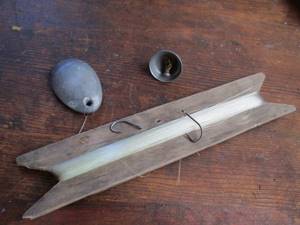
Donka (popularly known as casting) is a bottom tackle, that is, a fishing line and leashes with hooks, when cast into the water, lie at the bottom of the reservoir (if there is no current) or in the immediate vicinity of it (in the current), held by a sinker. Therefore, crucian carp, carp, and bream are successfully caught in lakes using a donka (cast bait), and in rivers - the same crucian carp, carp, bream, as well as silver bream, pike perch, perch, catfish, burbot and other bottom-dwelling fish. So what is a donka? This is a fishing line from 50 to 70 meters long, to which a sinker and two or three leashes with hooks are tied.
What to do when the bite starts?
- As soon as the bite occurs, you need to carefully make sure that the fish is well hooked, this is evidenced by the confident movement of the fishing line;
- Gently, with a sharp movement, hook in the opposite direction of the fish’s movement;
- Watch the behavior of the fish , a large specimen has great strength and can easily break loose;
Advice! Fishing must be done very carefully, otherwise the fish may fall off the hook.
- With a quick, confident movement, pull out the caught fish;
- Remove the hook and mouth and attach a new bait and cast again;
- When the bite weakens, it is recommended to tug on the feeder cord to improve the washing out of the bait.
When pulling out particularly large fish, you should not rush and be prepared for the line to break. When fishing at a depth of more than 10 meters, the fish may experience decompression due to rapid rise from the depth, so it will be easier to pull it out with the help of a fisherman.
Feeding fish on the Volga
As for feeding the place where bream is caught from a boat, you can prepare a mixture that the bream will definitely like. You should add something from animal food to the mixture, for example, bloodworms or maggots, and then add some plant components. Form several balls and feed the bream in the place where you catch it.
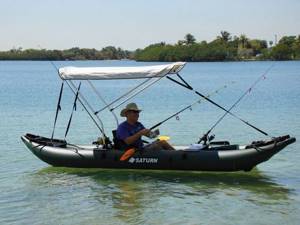
Also an excellent recipe for catching bream on the Volga is a mixture of soil from the Volga banks and chopped worms. Also form balls from the resulting mixture and feed the fish even in those places where there are nets. It is important to remember that the bait should not immediately settle to the bottom. If the current is strong, throw large bait balls first, and then smaller ones.
Bait can also be varied. Volga fishermen say that even pearl barley, which bream likes, will do. You can also use worms. Volga fish love ordinary worms, but they prefer dung worms, since they are able to lure them with the special smell that they emit. In addition, they will visibly squirm on the hook and will immediately attract bream.
There are also various recipes. You can mix maggots and bloodworms, because bream can be picky and don’t like other baits. But a bloodworm will always do. Combine it with corn, which will certainly give you a bite not only of bream, but also of roach or ide.
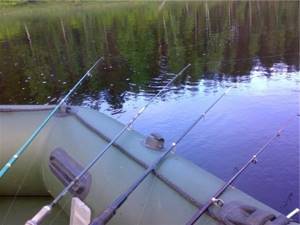
Now that you are well versed in all the intricacies of Volga bream fishing, you can safely go to those quiet and picturesque spaces. Fishing in these places in summer and autumn-spring will bring you not only unforgettable impressions of the beauty of nature and a feeling of tranquility, but also large bream, which you can safely call Volga trophies.
How to make a donk yourself
If you are planning to fish with donka, you should take into account a number of nuances. Firstly, as a rule, a thickness of 0.45 - 0.6 is chosen for the main line. For ease of storage and transportation, it is better to wrap the tackle on a board cut with a file at the ends and shaped like the letter “X”.
Secondly, it is necessary to use a fairly heavy, streamlined sinker so that there are no snags on the stones. As children, we poured a lead sinker, which, after melting in a tin can, was poured into a tablespoon. Today such sinkers are sold in fishing stores.
Thirdly, for leashes they use a fishing line of 0.25 - 0.3. It is better to have only two leashes (with hooks) on each bottom, which are attached to the main line above the sinker. Moreover, the lower leash should be tied so that when suspended, the hook hangs 30 - 40 centimeters below the sinker. To prevent the leashes from slipping along the main line, they must be tied with the correct knot.
The donka, as follows from the above, has a simple design and you can easily make it yourself.
Gear selection
The choice of jigging gear depends, first of all, on the desired casting distance. The length of such spinning rods ranges from 2.5 meters to 3 meters. It is important that they are equipped with:
- High quality braided cords.
- A playful tip, capable of responding to the slightest bites and the fall of the bait to the bottom of the reservoir.
The thickness of the cord is calculated based on the weight of the load. For jig hunting for pike in shallow waters, you can take rods that work with large but light baits. For large predators, largemouth bass, and ide, the following types of equipment are suitable:
- — diverter leash;
- - drop shot;
- - jig-rig;
- — tokyo-rig.
For them you will need rods with Fast or Regular Fast action, allowing you to cast over decent distances. Lead rigs involve attaching additional weight to the cord before or after the bait.
Models for twitching are selected according to a number of parameters. Their length ranges from 1.8 meters to 2.2 meters. It is better to purchase spinning rods with a fast action and a Tubular tip. They convey the movements of the wobblers well along the entire length of the blank and increase the casting range. For successful fishing, the rod must have the following qualities:
- — high rigidity;
- — no failures during roars;
- - ability to withstand heavy loads.
Suspender wobblers are suitable for twitching on fast-flowing rivers; cranks can be used for hunting chub and asp in small rivers and riffles. When fishing for pike perch and perch in coastal holes and dumps, shads will be the most effective; for fishing for pike and perch in shallow waters and lakes overgrown with algae, you need to take a rod that works with poppers and walkers.
If you plan to fish in hard-to-reach waters where the fish are not very sophisticated, you can try catching them using spinning rods with oscillating and rotating spoons. To do this, you need soft rods with a Regular Fast action and a length that provides the required casting distance. Hunting for asp will be most successful with jigs that do not go deep into shallow water. They will not scare away this cautious fish.
Tactics for catching bream with a ring
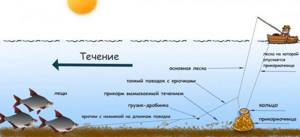
We anchor the boat, across the current, and lower the feeder to the bottom. The ring-weight is put through the cut onto the fishing line on which the feeder is lowered. Next, the bottom itself with bait on hooks (usually I use a worm) sinks to the bottom just to the feeder. Bait washed out by the current attracts fish to your bait. The accuracy of complementary feeding in this option is 100% and this ensures an excellent catch. The bite itself is easy to notice by the tip of the rod, which begins to twitch.
